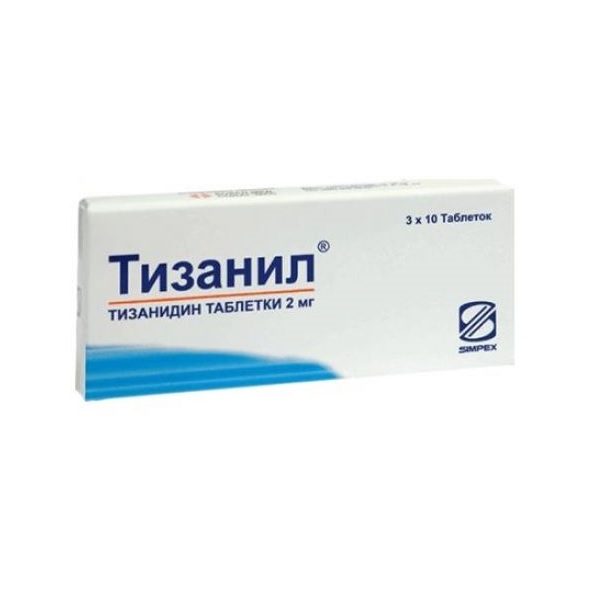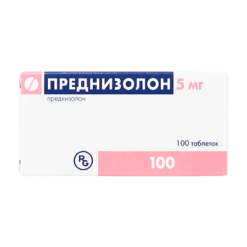No products in the cart.
Tizanil, tablets 2 mg 30 pcs
€5.37 €4.77
Description
Tizanil has a myorelaxant, analgesic effect. By stimulating presynaptic α2 receptors, it suppresses the release of excitatory amino acids that stimulate receptors for N-methyl-D-aspartate (NMDA-receptors). As a consequence, polysynaptic excitation transmission is suppressed at the level of intermediate spinal cord neurons. Since it is this mechanism that is responsible for excessive muscle tone, when it is inhibited, muscle tone decreases. It also has a central moderately pronounced analgesic effect.
Pharmacokinetics
It is absorbed rapidly and almost completely. Maximum plasma concentration is reached approximately 1 h after administration. Because of the pronounced metabolism during “first passage” through the liver, the average bioavailability is about 34%. Binding to plasma proteins is 30%. Tizanidine pharmacokinetics is linear in dose range from 4 to 20 mg. Interindividual variability of pharmacokinetic parameters is low. Gender has no effect on the pharmacokinetics of tizanidine.
It is metabolized in the liver, mainly by cytochrome P450 system isoenzyme 1A2. Metabolites are inactive. Elimination half-life is 2-4 hours. It is excreted mainly by kidneys as metabolites, a small part of it is excreted unchanged.
Indications
Indications
Active ingredient
Active ingredient
Composition
Composition
1 film-coated tablet contains:
active ingredients:
tizanidine 2 mg;
excipients:
MCC,
lactose monohydrate,
stearic acid,
silicon dioxide colloidal anhydrous
How to take, the dosage
How to take, the dosage
Treatment of painful muscle spasm: 2-4 mg 3 times a day, in severe cases an additional 2-4 mg at night.
The treatment of skeletal muscle spasticity in neurological diseases: the initial dose is 2 mg 3 times a day, then the dose is gradually increased by 2-4 mg at 3-7 day intervals. The optimal daily dose is 12-24 mg in 3-4 doses, the maximum daily dose is 36 mg.
In patients with renal insufficiency (at Cl creatinine < 25 ml/min) the administration is started with 2 mg once daily. If necessary, the dose is increased gradually, taking into account tolerability. If a more pronounced effect is needed, it is recommended to first increase the dose prescribed once daily, then the frequency of prescribing.
Interaction
Interaction
Simultaneous use of tizanidine with fluvoxamine or ciprofloxacin (CYP1A2 isoenzyme inhibitors) leads to a 33-fold increase in the AUC of tizanidine. As a result, clinically significant and prolonged BP decrease may occur, leading to drowsiness, weakness and delayed psychomotor reactions (in some cases, loss of consciousness); prolongation of the QT interval (see “Overdose”).
The concomitant use of tizanidine with other CYP1A2 isoenzyme inhibitors – antiarrhythmic drugs (amiodarone, mexiletine, propafenone), cimetidine, fluoroquinolones (enoxacin, pefloxacin, norfloxacin), rofecoxib, oral contraceptives, ticlopidine is not recommended.
The antihypertensive drugs increase the risk of marked BP decrease and bradycardia.
Ethanol, CNS depressants may increase the sedative effect of tizanidine; therefore, it is not recommended to use tizanidine concomitantly with CNS depressants and/or alcohol.
Special Instructions
Special Instructions
Liver function abnormalities associated with tizanidine have been reported, but these cases have been rare with daily doses up to 12 mg. In this regard, it is recommended to monitor liver function tests once a month during the first 4 months of treatment in patients treated with tizanidine at a daily dose of 12 mg or higher, as well as in cases when clinical signs suggestive of liver dysfunction are observed, such as unexplained nausea, anorexia, fatigue. In cases where serum AST and ALT levels persistently exceed VGN by a factor of 3 or more, Tizanil should be discontinued.
Patients with congenital QT interval prolongation syndrome should be prescribed with caution because preclinical studies of chronic toxicity in animals (dogs) have noted prolongation of the QT interval when using the drug at a dose equivalent to the maximum human dose.
In patients with coronary heart disease and/or heart failure, ECG should be monitored regularly.
In patients with myasthenia gravis, use with extreme caution only in cases where the expected benefit significantly exceeds the possible risk.
Impact on the ability to drive or perform work requiring increased speed of physical and mental reactions.
If drowsiness, dizziness, or decreased BP develop during therapy with Tizanil, refrain from activities requiring high concentration and rapid reactions, such as driving or operating machinery.
Contraindications
Contraindications
With caution:
Side effects
Side effects
Nervous system disorders: drowsiness, dizziness, hallucinations, insomnia, sleep disturbance.
System disorders: bradycardia, BP decrease (in some cases pronounced, up to collapse and unconsciousness).
Digestive system disorders: dry mouth, nausea, dyspepsia, increased liver transaminase activity, hepatitis, liver failure.
Musculoskeletal system: muscle weakness.
Others: increased fatigue, hypercreatininemia.
If the drug is abruptly withdrawn after prolonged treatment and/or high doses of the drug (and also after concomitant use with hypotensive drugs): tachycardia, increased BP, acute cerebral circulation disorder.
Overdose
Overdose
Symptoms: nausea, vomiting, decreased BP, dizziness, drowsiness, agitation, QT interval prolongation, miosis, anxiety, respiratory disorders, coma.
Treatment: gastric lavage, activated charcoal, assisted diuresis, symptomatic therapy.
Pregnancy use
Pregnancy use
Since controlled studies of tizanidine use in pregnant women have not been conducted, it should not be used in pregnancy unless the expected benefit to the mother outweighs the possible risk to the fetus.
Tizanidine slightly penetrates into the breast milk, so the drug should be discontinued during breastfeeding.
Similarities
Similarities
Additional information
| Shelf life | 3 years |
|---|---|
| Conditions of storage | In a dry, light-protected place at a temperature not exceeding 30 °C |
| Manufacturer | Simpex Pharma Pvt. Ltd. |
| Medication form | pills |
| Brand | #Н/Д |
Related products
Buy Tizanil, tablets 2 mg 30 pcs with delivery to USA, UK, Europe and over 120 other countries.
















